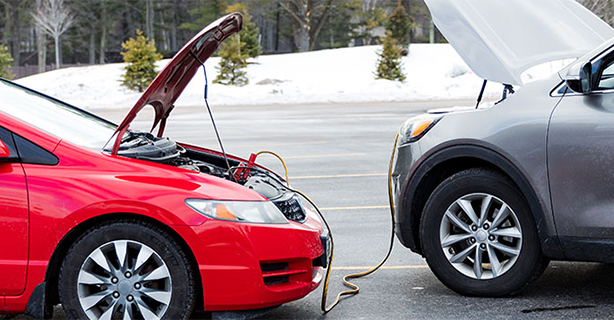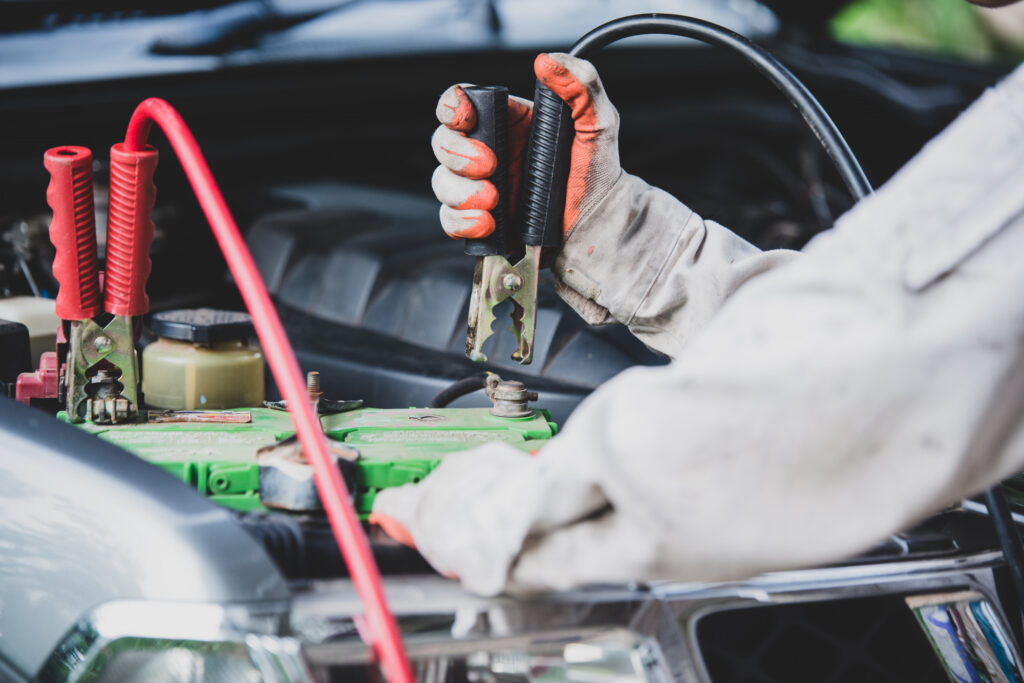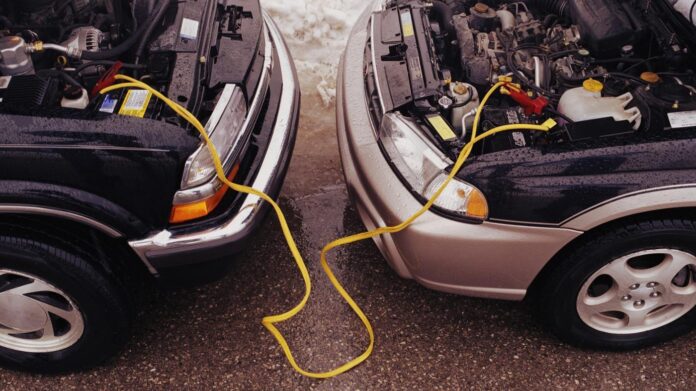A dead car battery can leave you stranded at the worst possible time, but knowing how to jump-start a car can save the day. Whether you have access to another vehicle or need to jump-start your car without one, the process is simple if done correctly. In this guide, we’ll walk you through step-by-step instructions for safely reviving your car battery, using either jumper cables and another vehicle or a portable jump starter. We’ll also cover safety precautions, troubleshooting tips, and ways to prevent battery failure in the future. Stay prepared and get back on the road in no time.
Key Points
- Understanding Why Your Car Won’t Start
- Safety Precautions Before Jump-Starting
- How to Jump-Start a Car Using Another Vehicle
- How to Jump-Start a Car Without Another Vehicle
- What to Do After a Successful Jump-Start
- When to Replace Your Car Battery
- Preventive Tips to Avoid a Dead Battery
Understanding Why Your Car Won’t Start

Maybe you left the headlights on overnight (we’ve all been there), or the battery’s just old and tired. Other culprits could be a faulty alternator, a loose connection, or even extreme weather zapping its juice. When you turn the key, listen up: a clicking sound usually screams battery, while no sound at all might mean a deeper issue. Knowing this helps you decide if a jump-start is your fix or if you’re calling a mechanic.
Safety Precautions Before Jump-Starting
First, park on a flat surface and turn off both cars (if you’re using another vehicle). Pop the hoods and check the batteries for leaks, cracks, or corrosion those white, crusty bits on the terminals. If it looks sketchy, stop right there and get help. Wear gloves and safety glasses if you’ve got, and keep anything flammable (cigarettes, lighters) far away. Oh, and double-check your jumper cables aren’t frayed safety first, always!
How to Jump-Start a Car Using Another Vehicle

Here’s the classic jump-start method:
- What You’ll Need: Jumper cables and a working car.
- Step 1: Position the cars close enough for the cables to reach, but not touching. Turn off the working car and pop both hoods.
- Step 2: Find the batteries. Spot the positive (+) and negative (-) terminals usually red for positive, black for negative.
- Step 3: Connect the cables:
- Clip one red clamp to the dead battery’s positive terminal.
- Clip the other red clamp to the working battery’s positive terminal.
- Clip the black clamp to the working battery’s negative terminal.
- Attach the last black clamp to an unpainted metal surface on your car’s engine block (not the battery think a bolt or bracket).
- Step 4: Start the working car and let it run for 2-3 minutes. Then, try starting your car.
- Step 5: If it fires up, awesome! Remove the cables in reverse order (black from metal, black from working battery, red from working battery, red from dead battery).
Pro tip: Don’t rush let the good battery share some love before you crank your engine.
How to Jump-Start a Car Without Another Vehicle

You’ve got options: a portable jump starter or, in a pinch, some elbow grease.
- Using a Portable Jump Starter: These little gadgets are like battery CPR in a box.
- Grab a charged jump starter (keep one in your trunk it’s a lifesaver).
- Connect the red clamp to your battery’s positive terminal and the black to the negative (or a metal ground if the manual says so).
- Turn it on, wait a minute, then start your car.
- Disconnect and recharge the jump starter later.
- Push-Starting (Manual Cars Only): Got a stick shift and a hill?
- Turn the key to “on,” push the clutch in, and shift to second gear.
- Get rolling (downhill or with a push from friends), then pop the clutch.
- If the engine catches, you’re golden drive to recharge it.
Learn more about portable jump starters from NOCO’s official website or check Consumer Reports for expert reviews.
What to Do After a Successful Jump-Start
Drive it around for at least 20-30 minutes to let the alternator recharge the battery highway speeds are best, not just idling. If you turn it off too soon, you might be back to square one. Keep an eye on the dashboard for warning lights (like the battery icon); if they glow, something’s up maybe the alternator or battery itself. Test the battery later to be sure it’s holding a charge.
When to Replace Your Car Battery

Batteries don’t last forever usually 3-5 years, depending on use and climate. If your car’s cranking slow even after a jump, or if it’s died on you a few times lately, it’s probably toast. Check the manufacture date (stamped on the battery) if it’s pushing 4+ years, consider a replacement. Corrosion, swelling, or a funky smell (like rotten eggs) are also red flags. Auto shops can test it for free; if it’s below 12.6 volts when fully charged, grab a new one.
Preventive Tips to Avoid a Dead Battery
Let’s keep this from happening again, yeah?
- Turn Off Everything: Headlights, radio, interior lights off before you leave the car.
- Drive Regularly: Short trips don’t fully charge the battery; take it for a spin weekly.
- Clean the Terminals: Scrape off corrosion with a wire brush and baking soda paste.
- Check the Alternator: If it’s not charging right, your battery’s doomed get it tested.
- Winter Prep: Cold kills batteries, so park in a garage or use a battery blanket in frigid temps.
Little habits like these can save you a ton of hassle down the road.
Conclusion
Knowing how to jump-start a car is an essential skill that can save you from being stranded. Whether you use jumper cables with another vehicle or a portable jump starter, following the correct steps ensures safety and efficiency. After successfully starting your car, let the engine run to recharge the battery and consider getting it checked to avoid future issues. Regular maintenance and carrying a jump starter can help prevent unexpected breakdowns. By staying prepared, you can handle a dead battery confidently and get back on the road without hassle.
Frequently Asked Questions
Q1. What do I need to jump-start a car with another vehicle?
Ans. You will need a set of jumper cables and a working car with a charged battery. Make sure both vehicles are parked safely, and follow the correct sequence to connect the cables.
Q2. How do I jump-start a car without another vehicle?
Ans. You can use a portable jump starter by connecting it to the battery terminals, turning it on, and starting your car. If you have a manual transmission, you can also try the push-start method by rolling the car and releasing the clutch in second gear.
Q3. What are the correct steps to jump-start a car with jumper cables?
Ans. To jump-start a car with jumper cables, first, park both vehicles close together but without touching, and turn off both engines while engaging the parking brakes. Locate the positive (+) and negative (-) battery terminals on both cars. Next, connect one red (positive) clamp to the dead battery’s positive terminal, then attach the other red clamp to the working battery’s positive terminal. After that, connect one black (negative) clamp to the working battery’s negative terminal, and the last black clamp to an unpainted metal surface on the dead car (not the battery). Start the working car and let it run for a few minutes before attempting to start the dead car. If it starts successfully, remove the cables in reverse order, ensuring safety throughout the process.
Q4. What safety precautions should I take before jump-starting a car?
Ans. Before jump-starting a car, ensure both vehicles are in park (automatic) or neutral (manual) with the parking brake engaged. Wear gloves and safety glasses, check the battery for leaks or damage, and keep flammable objects away. Also, never touch the metal ends of jumper cables together, and always follow the correct connection sequence.
Q5. How long should I let my car run after a jump-start?
Ans. After a jump-start, let your car run for at least 15–30 minutes or drive it around to allow the alternator to recharge the battery. If the battery is old or weak, consider getting it tested, as it may not hold a charge properly.
Q6. Why won’t my car start even after using jumper cables?
Ans. If your car won’t start even after using jumper cables, the battery might be completely dead and unable to hold a charge. Other possible causes include a faulty alternator, loose or corroded battery terminals, a bad starter, or an ignition system issue, all of which may require professional inspection.
Q7. Can I use a power bank to jump-start my car?
Ans. No, a regular power bank cannot provide enough power. However, dedicated portable jump starters are designed specifically for jump-starting car batteries.
Q8. Is it safe to push-start a car with a dead battery?
Ans. Yes, but only for manual transmission vehicles. Turn the ignition on, push the car to gain momentum, and release the clutch while in second gear to start the engine.
Q9. How often should I check my car battery to avoid jump-starting?
Ans. It’s recommended to check your battery every 3–6 months for signs of wear, corrosion, or low voltage. Most car batteries last 3–5 years, so replace them if they show signs of weakness.
Q10. What are the signs that my car battery needs replacement?
Ans. If your car battery needs replacement, you may notice slow engine cranking, dim headlights, or electrical malfunctions. Frequent jump-starts, a swollen battery case, or a battery warning light on the dashboard are also signs that it’s time for a new one.








